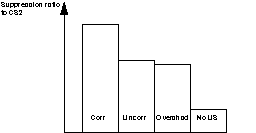| In addition to variations in the subjective characteristics, variations
in the history of these experiences were also investigated upon . Suppose
that two stimuli CS1 and CS2 will be paired with a single US. Rather than
presenting the two CSs together throughout the training of an animal only
CS1 is used in the first half of training and later the CS1-CS2 combination
together, just as in an overshadowing experiment for the second half of
training. The result, in general, is that when subsequently tested individually
the animal will show strong conditioning to CS1 and little or no conditioning
to CS2. The effect where the prior pairing of one stimulus with a US stops
the US being associated with other subsequently presented stimuli is called
blocking.
Procedure for a simple blocking experiment:
To control for the possible confounding effects of overshadowing, experiments were conducted, in which the roles of CS1 and CS2 were reversed so that CS2 was experienced paired by itself with the US in the 1st training before the 2nd training with the CS1-CS2 compound stimulus. In this experiment normally strong conditioning to CS2 and little conditioning to CS1 would be expected. In order to compare the effectiveness of overshadowing vs. blocking
and include some measure for the predictability of the CSs, a "blocking
and predictability" experiment could be devised:
Testing the strength of association between CS2 and the US using a suppression ratio procedure, Rescorla (1971) found the results depicted in the diagramm below: the strength of conditioning to CS2 acquired during 2nd training was much weaker in the group which had received prior correlated parings of CS1 and the US than in the groups which had received no prior pairings (overshadowing) or which had received random presentations of CS1 and the US. Finally, the group which had received CS1 alone with no US in phase 1 showed even stronger conditioning to CS2 than the overshadowing or uncorrelated controls.
|
